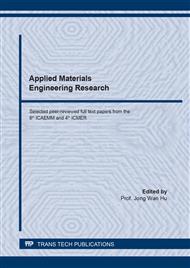[1]
N. Birbilis, T. Muster, R.G. Buchheit, Corrosion of aluminum alloys. corrosion mechanisms in theory and practice, 3rd. Ed., CRC Press, 2011, pp.705-736.
Google Scholar
[2]
J.R. Davis, Corrosion of aluminum and aluminum alloys, ASM International, Materials Park, Ohio, USA, (1999).
Google Scholar
[3]
O. Makanjuola, O. Kayode, O. John, O. Samuel, Inhibition of aluminium in HCl by amine modified epoxy resin, J. Mater. Sci. (2013) 479728. http://dx.doi.org/10.1155/2013/479728.
Google Scholar
[4]
S.P. Sivam, A. Kumar, K. Sathiya, S. Rajendrakumar, Investigation exploration outcome of heat treatment on corrosion resistance of AA 5083 in marine application, Int. J. Chem. Sci. 14(S2) (2016) 453-460.
Google Scholar
[5]
E.F. Bruhn, Analysis and design of flight vehicle structures, Jacobs Publishing Inc., Florida, USA, (1972).
Google Scholar
[6]
S. Wernick, R. Pinner, P.G. Sheasby, The surface treatment of aluminum and its alloys, ASN International Finishing Publications Ltd., Teddington, UK, (1987).
Google Scholar
[7]
A. Bertila, F. Matilde, T. Oladis, A. Silagdy, C. Melani, R. Jomar, C. Raúl, Corrosion costs in preventive and corrective maintenance in equipment and facilities in industry, Rev. Tec. Fac. Ing. Univ. 36(1) (2013) 23 – 33.
Google Scholar
[8]
E. Maria-Cristiana, P.N. Ileana, Z. Raluca, M. Alina, B. Vasile, Influence of heat treatment on microstructure and corrosion behaviour of 7 series Al alloys, Proceedings of the 2nd International Conference on Manufacturing Engineering, Quality and Production Systems (MEQAPS'10). Constantza, Romania, (2010).
Google Scholar
[9]
T. Hurlen, H. Lian, O.S. Odegard, T.V. Valand, Corrosion and passive behaviour of aluminium in weakly acid solution, Electrochim. Acta. 29 (1984) 579-585.
DOI: 10.1016/0013-4686(84)87113-3
Google Scholar
[10]
V. Mountarlier, M.P. Gigandet, B. Normand, J. Pagetti, EIS characterisation of anodic films formed on 2024 aluminium alloy, in sulphuric acid containing molybdate or permanganate species, Corros. Sci. 47(1) (2005) 937-951.
DOI: 10.1016/j.corsci.2004.06.019
Google Scholar
[11]
I. Lukovits, E. Kalman, F. Zucchi, Corrosion inhibitors—Correlation between electronic structure and efficiency, Corrosion. 57 (2001) 3-9.
DOI: 10.5006/1.3290328
Google Scholar
[12]
C.M. Brett, On the electrochemical behaviour of aluminium in acidic chloride solution, Corros. Sci. 33(2) (1992) 203-210.
DOI: 10.1016/0010-938x(92)90145-s
Google Scholar
[13]
C.M.A. Brett, I.A.R. Gomes, J.P.S. Martins, The electrochemical behaviour and corrosion of aluminium in chloride media. The effect of inhibitor anions, Corros. Sci. 36 (1994) 915-923.
DOI: 10.1016/0010-938x(94)90194-5
Google Scholar
[14]
S.Z. El Abedin, Role of chromate, molybdate and tungstate anions on the inhibition of aluminiumin chloride solutions, J. Appl. Electrochem. 31 (2001) 711-718.
Google Scholar
[15]
T.R. Beck, Size distribution of etch pits in aluminium, Electrochim. Acta. 33(10) (1998) 1321-1327.
Google Scholar
[16]
T. Hu, H. Shi, T. Wei, F. Liu, S. Fan, E. Hana, Cerium tartrate as a corrosion inhibitor for AA 2024–T3, Corros. Sci. 95 (2015) 152-161.
DOI: 10.1016/j.corsci.2015.03.010
Google Scholar
[17]
E-S.M. Sherif, Effects of 3-amino-1,2,4-triazole-5-thiol on the inhibition of pure aluminum corrosion in aerated stagnant 3.5 wt.% NaCl solution as a corrosion inhibitor, Int. J. Elect. Sci. 7 (6) (2012) 4847-4859.
Google Scholar
[18]
R. Catubig, A.E. Hughes, I.S. Cole, B.R.W. Hinton, M. Forsyth, The use of cerium and praseodymium mercaptoacetate as thiol-containing inhibitors for AA2024-T3, Corros. Sci. 81 (2014) 45-53.
DOI: 10.1016/j.corsci.2013.12.001
Google Scholar
[19]
S. Zor, S. Saǧdinç, Experimental and theoretical study of sulfathiazole as environmentally friendly inhibitor on aluminum corrosion in NaCl, Prot. Met. Phys. Chem. Surf. 50(2) (2014) 244-253.
DOI: 10.1134/s207020511402018x
Google Scholar
[20]
N.V. Lakshmi, N. Arivazhagan, S. Karthikeyan, The corrosion inhibition of aluminium in 3.5% NaCl by diisopropyl thiourea, Int. J. Chemtech Res.5(4) (2013) 1959-1963.
Google Scholar
[21]
D. Snihirova, S.V. Lamaka, P. Taheri, J.M.C. Mol, M.F. Montemor, Comparison of the synergistic effects of inhibitor mixtures tailored for enhanced corrosion protection of bare and coated AA2024-T3, Surf. Coat. Technol. 303(B) (2016) 342-351.
DOI: 10.1016/j.surfcoat.2015.10.075
Google Scholar
[22]
R.T Loto, C.A. Loto, Effect of P-phenylediamine on the corrosion of austenitic stainless steel type 304 in hydrochloric acid, Int. J. Elect. Sci.7(10) (2012) 9423-9440.
DOI: 10.1007/s12633-015-9344-1
Google Scholar
[23]
R.T. Loto, Anti-corrosion performance of the synergistic properties of benzenecarbonitrile and 5-bromovanillin on 1018 carbon steel in HCl environment, Sci. Reps. 7(1) (2017) 17555.
DOI: 10.1038/s41598-017-17867-0
Google Scholar
[24]
C.A. Loto, R.T. Loto, A.P.I. Popoola, Effect of neem leaf (azadirachita indica) extract on the corrosion inhibition of mild steel in dilute acids, Int. J. Phys. Sci. 6(9) (2011) 2249-2257.
DOI: 10.17159/0379-4350/2015/v68a16
Google Scholar


